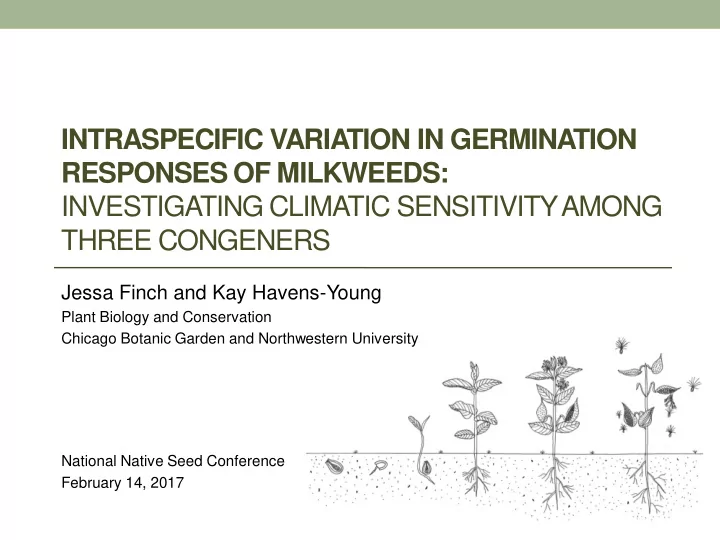

INTRASPECIFIC VARIATION IN GERMINATION RESPONSES OF MILKWEEDS: INVESTIGATING CLIMATIC SENSITIVITY AMONG THREE CONGENERS Jessa Finch and Kay Havens-Young Plant Biology and Conservation Chicago Botanic Garden and Northwestern University National Native Seed Conference February 14, 2017
Interspecific between species Intraspecific within species (Alex Seglias) Restoration
Adult Life Early Life Stages Stages Restoration Seeds: Steve Hurst, USDA-NRCS PLANTS Database
(Alex Seglias) National Seed Strategy Objective 2.2: Conduct species-specific research to provide seed technology, storage, and production protocols for restoration species
(Alex Seglias) Field Lab Research Aim: Investigate interspecific and intraspecific variation of early life stages of three milkweeds
Study Species (Family: Apocynaceae, Sub-Family: Asclepiadoideae) Species Asclepias syriaca Asclepias verticillata Asclepias incarnata Common milkweed Whorled milkweed Swamp milkweed Common Name Flower Pink, mauve White Deep pink Breeding Primarily self-incompatible Self-incompatible Primarily self-compatible Pollination Large bees, butterflies Small bees, wasps Large bees, butterflies, wasps Clonal High Medium No Roadsides, old fields, Roadside, dry prairies, Habitat Wetlands, wet prairies forest edges open hillsides
Study Species (Family: Apocynaceae, Sub-Family: Asclepiadoideae) Species Asclepias syriaca Asclepias verticillata Asclepias incarnata Common milkweed Whorled milkweed Swamp milkweed Common Name Flower Pink, mauve White Deep pink Breeding Primarily self-incompatible Self-incompatible Primarily self-compatible Pollination Large bees, butterflies Small bees, wasps Large bees, butterflies, wasps Clonal High Medium No Roadsides, old fields, Roadside, dry prairies, Habitat Wetlands, wet prairies forest edges open hillsides * Asclepias seeds have physiological dormancy broken by cold-moist stratification
Seed Collections (Fall 2015) Monarch Butterfly ( Danaus plexippus ) Swamp milkweed (n=10) Common milkweed (n=9) Whorled milkweed (n=7)
Methods Cold Stratify Plate on agar Viability testing Collection Thermo-gradient Score table or incubator germination Viability testing Experiment Cold Stratification Incubation 15/6˚C 1. Cold Stratification Length 0, 4, 8, 12, 16, 20 weeks (3˚C) 0, 12 weeks (3˚C) 15/6 - 20/10˚C 2. Germination Temperature
Cold Stratification Length Common milkweed Whorled milkweed Swamp milkweed 15/5ºC 15/5ºC 15/5ºC Common milkweed Swamp milkweed Whorled milkweed 25/15ºC 25/15ºC 25/15ºC
Cold Stratification Length Common milkweed Whorled milkweed Swamp milkweed 15/5ºC 15/5ºC 15/5ºC Common milkweed Swamp milkweed Whorled milkweed 25/15ºC 25/15ºC 25/15ºC
Incubation Temperature Common milkweed Whorled milkweed Swamp milkweed 0 weeks (non-stratified) 0 weeks (non-stratified) 0 weeks (non-stratified) Common milkweed Whorled milkweed Swamp milkweed 12 weeks (3°C) 12 weeks (3°C) 12 weeks (3°C)
Incubation Temperature Common milkweed Whorled milkweed Swamp milkweed 0 weeks (non-stratified) 0 weeks (non-stratified) 0 weeks (non-stratified) Common milkweed Whorled milkweed Swamp milkweed 12 weeks (3°C) 12 weeks (3°C) 12 weeks (3°C)
Germination Tolerance Range Common milkweed Whorled milkweed Swamp milkweed south north south north south north Population (Levins, 1968; Feinsinger et al., 1981; Barak et al. 2015)
Field Germination Study (2015-16)
Field Emergence & Establishment Common Milkweed Swamp Milkweed south north south north
Implications for Milkweed Production
Implications for Seed Sourcing • Lab-based TR was not a good predictor of field response • Greater variation among populations than species or regions → refine seed zones with site matching
Acknowledgements Kayri Havens-Young, Andrea Kramer, Jeremie Fant, Jeffrey Walck Kramer-Havens Lab, Alex Seglias Victoria Lason, Henny Kim, Tia Chung-Swanson, Ushna Jadoon, Rachel Kreb Chicago Botanic Garden Plant Production and Grounds Departments, Brian Clark Bureau of Land Management, Illinois Association of Environmental Professionals, Illinois State Academy of Science, NU Plant Biology and Conservation, National Science Foundation Research Experiences for Undergraduates Midewin National Tallgrass Prairie and Tyson Research Center
Questions? Jessa Finch, Chicago Botanic Garden jfinch@chicagobotanic.org
The preceding presentation was delivered at the 2017 National Native Seed Conference Washington, D.C. February 13-16, 2017 This and additional presentations available at http://nativeseed.info
Recommend
More recommend